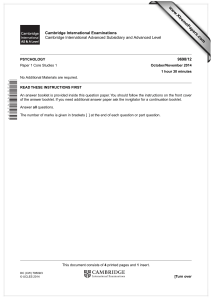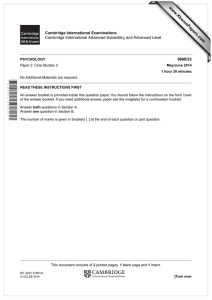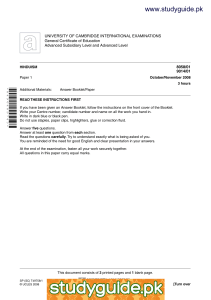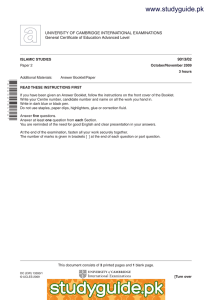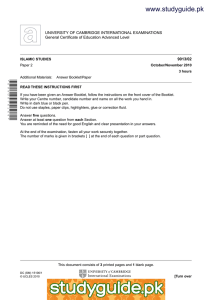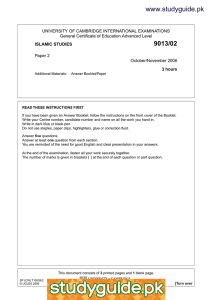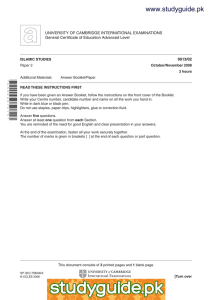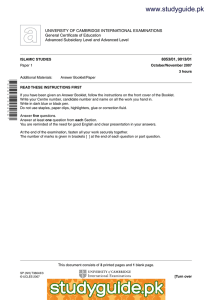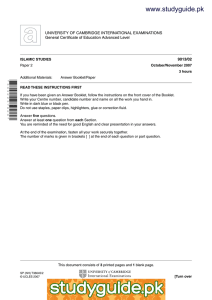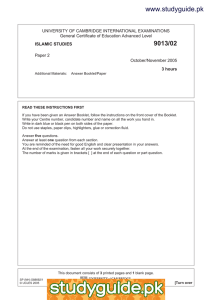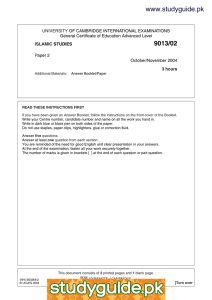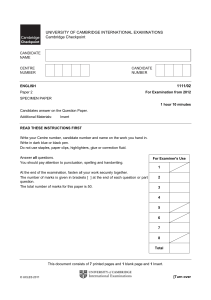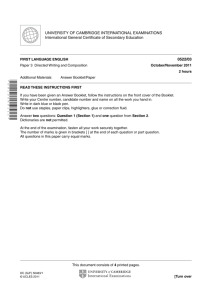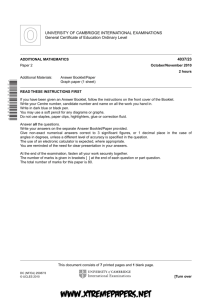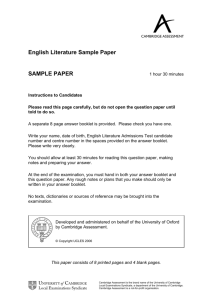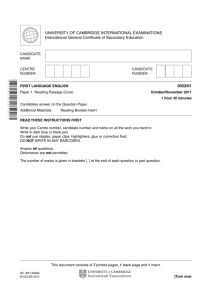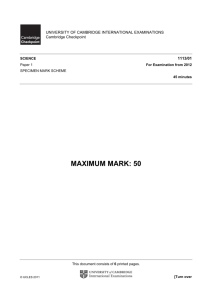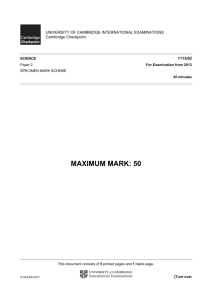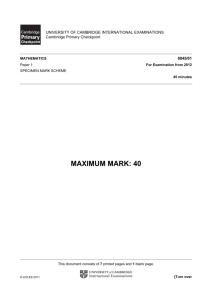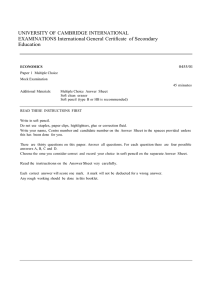File
advertisement
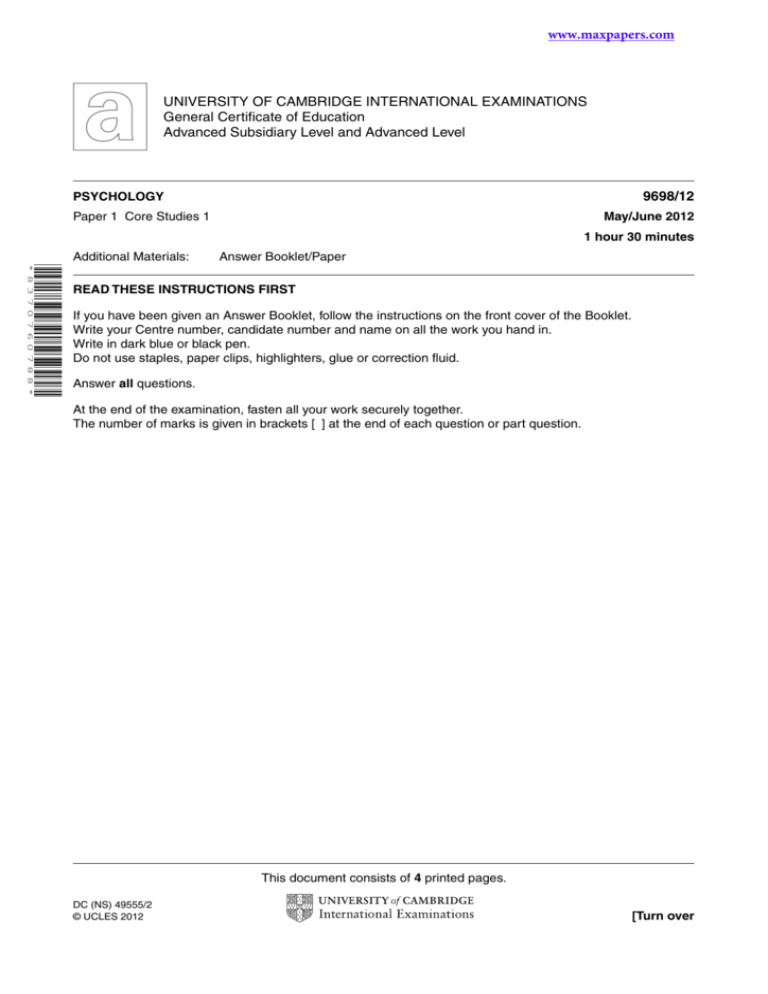
www.maxpapers.com UNIVERSITY OF CAMBRIDGE INTERNATIONAL EXAMINATIONS General Certificate of Education Advanced Subsidiary Level and Advanced Level 9698/12 PSYCHOLOGY Paper 1 Core Studies 1 May/June 2012 1 hour 30 minutes Additional Materials: Answer Booklet/Paper * 8 3 7 0 7 6 0 7 8 8 * READ THESE INSTRUCTIONS FIRST If you have been given an Answer Booklet, follow the instructions on the front cover of the Booklet. Write your Centre number, candidate number and name on all the work you hand in. Write in dark blue or black pen. Do not use staples, paper clips, highlighters, glue or correction fluid. Answer all questions. At the end of the examination, fasten all your work securely together. The number of marks is given in brackets [ ] at the end of each question or part question. This document consists of 4 printed pages. DC (NS) 49555/2 © UCLES 2012 [Turn over www.maxpapers.com 2 Section A (60 marks) Answer all questions in this section. 1 From the study by Mann et al (lying): (a) Describe one individual difference in deceptive behaviour. [2] (b) Explain why Mann et al challenged the simplistic view that typical deceptive behaviour exists. [2] 2 From the study by Loftus and Pickrell (false memories): (a) Explain what the participants believed the study was about. [2] (b) Explain why this was necessary. [2] 3 Baron-Cohen et al (eyes test) used four groups of participants. Describe two of these groups. [4] 4 From the study by Milgram (obedience): (a) Describe how the experimenter tried to stop participants from withdrawing from the study. [2] (b) Why are participants given the right to withdraw from psychology studies? 5 6 [2] In the prison simulation by Haney, Banks and Zimbardo, the prisoners were given a distinctive uniform. (a) Identify two features of the prisoners’ uniform. [2] (b) What effect did the uniform have on the prisoners’ behaviour? [2] From the study by Piliavin et al (subway Samaritans): (a) Describe two behaviours of the ‘drunk’ victim. [2] (b) Describe one way in which the results of the ‘drunk’ condition differed from those of the ‘ill’ condition. [2] 7 Using the study by Tajfel on intergroup categorisation: (a) Outline one key feature of ethnocentrism. [2] (b) According to Tajfel, what are the minimum conditions for creating ethnocentrism? [2] © UCLES 2012 9698/12/M/J/12 www.maxpapers.com 3 8 In the study by Freud, little Hans is referred to as ‘a little Oedipus’. (a) Briefly outline the Oedipus complex. [2] (b) Describe one piece of evidence from the study which suggests that Hans is ‘a little Oedipus’. [2] 9 Langlois et al (infant facial preference) suggested three reasons why study 1 was done. Explain two of these reasons. [4] 10 From the study by Nelson (children’s morals): (a) Describe the pictures in the motive-implicit condition. [2] (b) Explain what was different about the pictures in the motive-explicit condition. [2] 11 From the study by Schachter and Singer (emotion): (a) Identify the two factors from the two-factor theory of emotion. [2] (b) How was each factor manipulated in the study? [2] 12 The study by Dement and Kleitman (sleep and dreaming) used a self report method. (a) Outline how the self report method was used in this study. [2] (b) Describe one problem with self report data in this study. [2] 13 From the study by Maguire et al (taxi drivers): (a) Describe one way in which experienced taxi drivers are unusual in their way-finding. [2] (b) Describe one way in which experienced taxi drivers are similar to other people in their way-finding. [2] 14 What were the four odours used in the study by Demattè et al (smells and facial attractiveness)? [4] 15 From the results of long mirror checking sessions in the study by Veale and Riley: (a) Give two uses of the mirror by body dysmorphic disorder (BDD) patients. [2] (b) Give two uses of the mirror that were more common in the control participants than the BDD patients. [2] © UCLES 2012 9698/12/M/J/12 [Turn over www.maxpapers.com 4 Section B (20 marks) Answer both questions in this section. 16 Evaluate one of the studies listed below in terms of its contribution to the nature-nurture debate. Held and Hein (kitten carousel) Bandura et al (aggression) Nelson (children’s morals) [10] 17 Discuss the strengths and weaknesses of the psychology of individual differences using one of the studies listed below as an example. Rosenhan (sane in insane places) Thigpen and Cleckley (multiple personality disorder) Billington et al (empathising and systemising) [10] Permission to reproduce items where third-party owned material protected by copyright is included has been sought and cleared where possible. Every reasonable effort has been made by the publisher (UCLES) to trace copyright holders, but if any items requiring clearance have unwittingly been included, the publisher will be pleased to make amends at the earliest possible opportunity. University of Cambridge International Examinations is part of the Cambridge Assessment Group. Cambridge Assessment is the brand name of University of Cambridge Local Examinations Syndicate (UCLES), which is itself a department of the University of Cambridge. © UCLES 2012 9698/12/M/J/12

